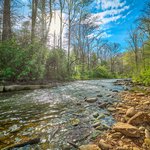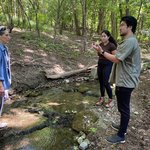News
(May 28, 2025)
What Can Ancient Climate Tell Us About Modern Droughts?Researchers from Syracuse University and the United Kingdom found chemical clues in ancient South African sediments linking past atmospheric shifts to droughts that mirror Cape Town’s Day Zero crisis.

(May 23, 2025)
Rock Record Illuminates Oxygen HistoryA team of researchers from Syracuse University and MIT uncovered evidence that oxygenation in the ocean—crucial for life as we know it—may have occurred earlier than previously thought, offering new insights into the evolution of our planet.
(May 13, 2025)
Forecasting the Future with FossilsPh.D. graduate’s paleontology research may shed light on ecological and animal responses to past, future climate change.

(March 3, 2025)
What Created Czech Republic’s Distinctive Geology?Fulbright award enables A&S professor to travel to the Czech Republic to investigate the European Cenozoic rift system.

(Feb. 28, 2025)
America’s Rivers May Hold a Key to Carbon CaptureResearchers at Syracuse University are integrating traditional geochemistry with artificial intelligence to forecast the impact of climate warming and population growth on the alkalinity and salt levels in rivers nationwide.

(Sept. 11, 2024)
Spring Disappearance and Backyard Flooding? A&S Researchers Explore if Climate Change and/or Human Intervention are to BlameA faculty and student team from the Department of Earth and Environmental Sciences is installing urban stream monitoring stations to investigate how extreme precipitation and other factors are affecting a Syracuse waterway.

(June 27, 2024)
Scientists Untangle Interactions Between the Earth’s Early Life Forms and the Environment over 500 million YearsSyracuse University Thonis Family Professor Zunli Lu leads an interdisciplinary group exploring how biology and the physical environment co-evolved.

(June 17, 2024)
What’s Driving Increased Rainfall in the Eastern U.S.?Thonis Family Professor Tripti Bhattacharya and postdoctoral researcher David Fastovich have received a three-year, $547,000 NSF grant to explore how ancient climate data can inform future forecasting.
